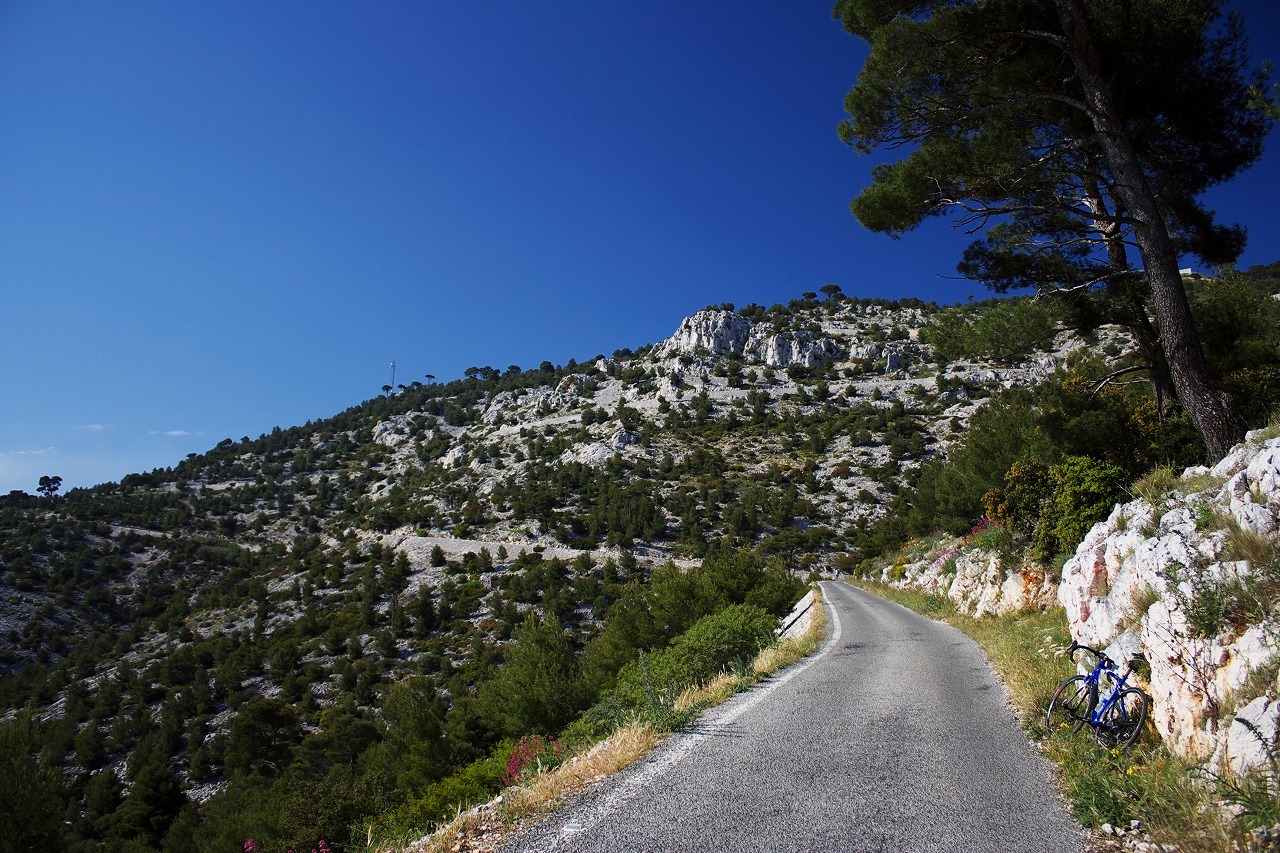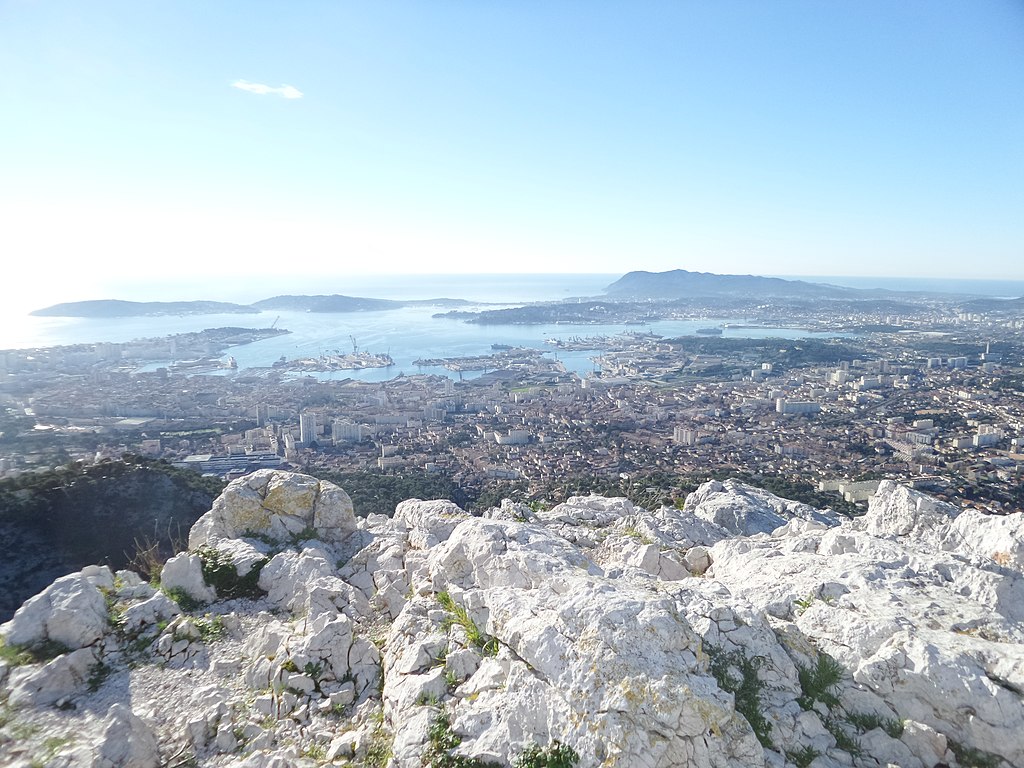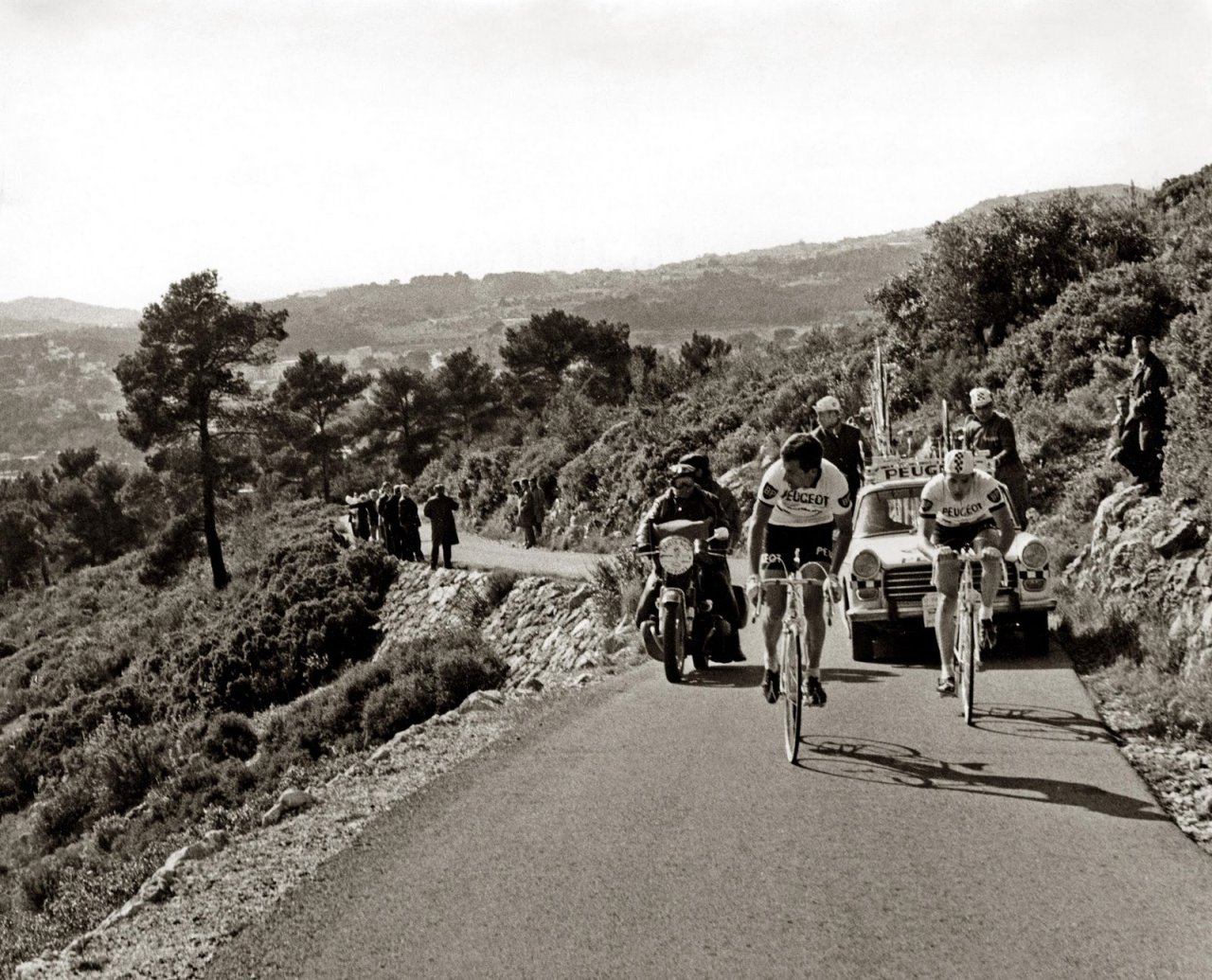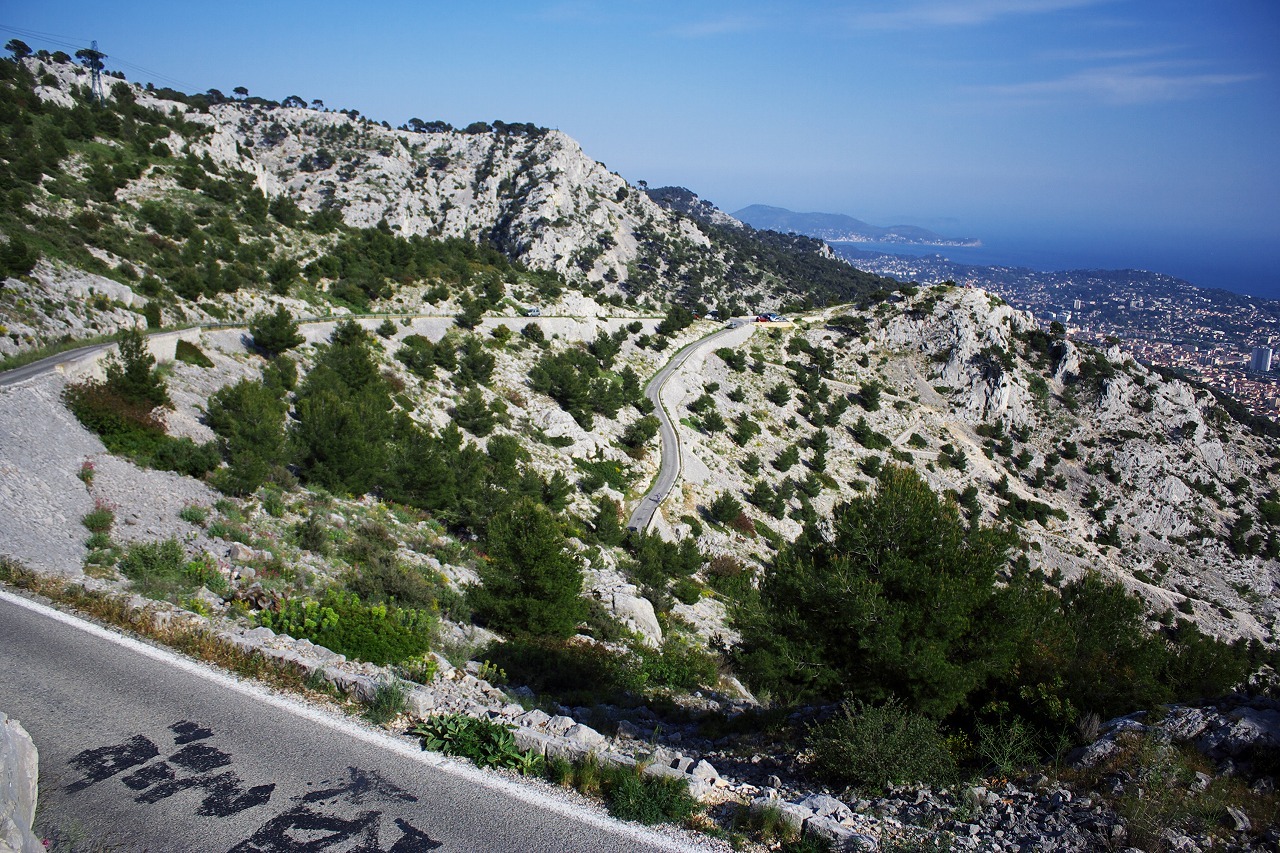It’s still there. Mont Faron used to be a fixture on the cycling calendar, and often the first summit finish of the year, but the demise of several races mean it’s no longer used in racing and now belongs on a list of forgotten climbs… more of which below.
The racing has gone but this mountain remains as an attractive climb and a good test, plus it’s revealed a few names in recent years, including Chris Froome’s first noticeable result.
 The Route: the Chemin du Fort Rouge starts in Toulon, the naval port city in the Var department of France. It is 4.1km long and averages 9.3%. The profile above shows a slightly longer version which starts earlier in the city.
The Route: the Chemin du Fort Rouge starts in Toulon, the naval port city in the Var department of France. It is 4.1km long and averages 9.3%. The profile above shows a slightly longer version which starts earlier in the city.

The Feel: Toulon’s famous as a port, the home for much of the French naval fleet but what strikes the cyclist is the way the town is surrounded by cliffs with Mont Faron a fixture on the horizon. Stroll around town and every time there’s a view down a street, the Faron’s white limestone shines back. You can’t miss it once you start riding towards but to help there are signposts for the mountain. The road starts climbing before you hit the mountain proper as you pass houses with identikit architecture in regulatory light beige or salmon pink tones. Then comes a right-hand bend and the road narrows and the gradient kicks up, you’ll see the clues as the fences running alongside the road rise at an angle.
There is a narrow road but it’s one way which sounds good but seems to make local drivers more expectant that they can overtake the cyclist and many are in a hurry to get to the top. There are wide hairpins, presumably to let larger vehicles through but ideal to attack by riding through the apex as you stand on the pedals. The gradient bites but it’s regular, something which cannot be said for the road itself. It pays to pick your line across the rough road, the granular surface has its cracks and patchwork quilt repairs and it’s reminiscent of how they used to build roads. All around you the limestone geology seems to afford little soil and the stunted pine trees allow views of the port as you climb and the higher you go the more exposed it gets.

The climb is repetitive with long zig and zag sections each broken by hairpins and lined by the bonzai pines and it’s only the way you gain altitude that lets you know the top can’t be far away. Don’t be fooled by the short distance, it may only be just over four kilometres but it takes time, many a pro would struggle for 15 minutes, a climbing rate (VAM) in excess of 1500m/h. This makes ideal for training although only on the right days as the wind can howl in these parts. Ride in the area and you might notice the local buses called “Mistral”, named after the local wind. If it’s your first time up then the visual cue that you’re near the top is when you climb high enough to glimpse over the shoulder of the mountain and can see inland for the first time, from here there’s not much more to go and soon the final bend arrives and cable car station marks the top.
The Verdict: people will go out of their way to climb Alpe d’Huez, the Tourmalet and Mont Ventoux. This is a much smaller climb and not celebrated in the same way but worth the detour if you’re passing. It’s a solid effort in a scenic and almost forgotten part of France when it comes to the cyclist’s psychogeography. The rough surface spoils what would otherwise be a perfect climb with its steep pitch and rewarding views.

Ride more: the Faron is a natural boundary to Toulon and once you’ve climbed up there’s only one road back down meaning the climb is good for a short effort rather than a component of a longer ride. That view of the hills inland you saw when you were near the top? You probably saw Mont Caume and that’s a good 10km climb at 6% with some very scenic sections. There’s more to do in the area with Mont Coudon a short spin away up the D446 road, 6km at 7%. Both of these are good efforts and a lot quieter.
If you want a longer ride then it pays to be ambitious and really plan a long day out as the hills inland are great place to lose yourself for hours, the wilderness of Pagnol novels where still you expect to come across shepherds. To the north-west is the Col de l’Espigoulier often used by riders from Marseille and to the north-east the Massif des Maures where Collobrières makes a good destination.

History: the first appearance in a major race seems to be the 1957 Tour de France when Jean Stablinksi went over the top first on the way to Marseilles. It’s been famous of late because of the now defunct Tour Méditerranéen but was used before in another extinct race called the Tour du Sud-Est and also used regularly in the past in Paris-Nice. The likes of Tom Simpson, Eddy Merckx, Federico Bahamontes and Raymond Poulidor all won on the summit.
The 1968 Paris-Nice tried an innovation with the Meilleur Descendeur prize for the fastest rider down, appropriately sponsored by a ski manufacturer. Thankfully for rider safety this downhill innovation didn’t survive.

It’s long been a place to spot emerging riders given there’s no way to hide on a steep climb. In 2009 an unknown rider called Chris Froome placed third behind Juan-Mauricio Soler and David Moncoutié with the Frenchman taking one of his four wins on this mountain, in the Tour méditerranéen, the record. The last winner was Jean-Christophe Péraud who took the summit finish in his dream season which included his Tour de France podium finish.

Forgotten climbs: the Mont du Chat, the Col du Granon, the Luitel, Mont Cenis and Col de Braus are examples of names that have featured in the Tour de France and other races only to vanish from the collective memory. The Mont du Chat probably terrified half the peloton while the Col de Braus was a regular in many races with 29 appearances in the Tour de France alone until it stopped in 1961. Other names like Guzet-Neige, Orcières-Merlette and the Puy de Dôme haven’t been used for decades but live on in memories as they’ve been associated with legendary tales. They can still play a role today, much like Pra-Loup where the Tour de France returned last summer and dined out on nostalgia of Thévenet and Merckx.
Travel and access: Toulon has road and rail connections but sits in between Marseille and the Côte d’Azur which have better connections. The area used to be popular for pre-season training camps with pro teams but like some races this has been displaced elsewhere. The weather is often sunny but the Mistral wind can be savage.
- Photo credits: top photo and halfway up the climb photo by Flickr’s Muneaki
More roads to ride at inrng.com/roads


The new incarnation of the Tour of the Mediterranean is close by today, although not visiting. Good climb made a little more difficult by the rough surface as you say INRNG. Even if the TdF has forgotten for financial reasons some of its roots, there are many race organizers who still remember their and its history. Don’t be to quick to write Faron’s obituary, just yet it hasn’t seen the last of struggles on the bike.
I’m not sure if the Tour can return given the small road, it’s unclear if the caravan would fit or if the mountain could take the crowds. Maybe it appears in Paris-Nice first as a trial?
I thought that the the Tour generally avoids this whole area of the Med because it is so crowded with tourists in July that to shut down the roads would be a major inconvenience for the tourism industry in one of their peak months. The closest we seem to get these days is a jaunt through Provence (other than the Monaco Grand Depart a few years back). One of the things that makes the Giro so picturesque is that it takes place outside peak tourist season so it can generally take in the roads around most of Italy’s glamour spots….not that France is short of beautiful places to run its race. during busy July.
Faron has the famous view and the sports history but I suggest Mont Caume and Le Coudon are better. The roads are wilder, more challenging and have lots of scenery. My old club would use Hyères for a training camp in February and these climbs always featured.
Mont du Chat ranks up there as one of France’s toughest climbs. Too bad it’s just hard and not very interesting.
“The 1968 Paris-Nice tried an innovation with the Meilleur Descendeur prize for the fastest rider down, appropriately sponsored by a ski manufacturer. Thankfully for rider safety this downhill innovation didn’t survive.”
Rider safety? I assume they were allowed to use bicycles with working brakes? Careful, you’re starting to sound like Andy Schleck, one of those who wants everything they’re not the best at removed from the parcours. I would LOVE to see something like this brought back. Cycling shouldn’t be all about watts/kg.
I agree. INRNGs comment made me think of downhill skiing. I’ve heard top skiers say you can never go “all in”, only keep it at, say, 95 per cent. Too much risk will have you injured or worse. I guess that’s exactly the attitude of the best descenders in road cycling, and I believe they would stick to that attitude even if there was a prize up for grabs in the valley. In grand tours, a “descender’s jersey” may come closer to achieve what the climber’s jersey rarely does – to award a specific type of rider too specialized in one aspect of the sport to ever compete for the overall.
Yes, it is the most incredible skill to watch: personally, I find it terrifying just to watch them, but it is sometimes the best part of the day – with Sky’s style of riding, this is often the only chance an individual has to attack to make a difference. (Unfortunately, it’s often missed due to adverts – TV people have to learn that watching the train go up a hill is not always the most important part of the race: racing has changed. Put an advert in anywhere up to, say, 7km to go on a climb and the chances are you’ll miss nothing.)
I’ll always remember the 2013 Giro where Nibali came off on a hairpin. He hadn’t stopped sliding along the soaked road before he was up and grabbing his bike. Then, he descended like nothing had happened, whilst Wiggins rode like newborn gazelle on ice. The vast majority of us would be like Wiggins, which is precisely what makes the great descenders so impressive. (Sagan’s descent was probably the highlight of this year’s Tour.)
+1 J Evans.
Ditto for the Lombardia – an incredible thing to watch.
@ J Evans
I remember an interview of the Squallo in which he said that local doctors knew him well at the local hospital when he was a young boy. In fact he even told a doctor to do a go job stitching his leg because he was going to be a Pro one day! It’s not only skill, you have to have a steel set of cahones (cojones in proper Spanish IIRC).
Excellent point about the skiers. Too many think guys like Nibali, Sagan or Savoldelli before them (and maybe Nencini before them?) are crazy, wild men who throw caution to the wind when the road goes downhill. It’s a skill thing and why not test a bit more of it instead of ever-more tests that reveal little more than watts/kg and thereby reward doping?
There’s no such thing as a dangerous descent. I can barely ride a bike, but there is no hill I couldn’t go down safely – you just pick *your* safe speed. I remember Chris Boardman saying as much – I think it was during the 2011 Tour, where Schleck was whining about having to go downhill (and pushing people out of his way at the top of one climb so he could be first to descend, in an effort to prevent others from going quickly – I think it was was the one with all the tress where Voeckler went off the road).
Here’s an example of the watts/powermeter issue:
Jack Bobridge on winning the 2016 Australian title:
‘Bobridge added that his powermeter was key to judging his efforts across the day with every watt vital to ensuring he stayed ahead of the chasers.
“Every time up the climb, I watched my power meter and I knew what I could do. To do 60km down the hill, to do 62km, you have do an extra 60 watts so it wasn’t worthwhile. It was worth putting the extra 60 watts up the hill and holding them off. It was a real tactical game for me in terms of watching the power meter and really watching the effort right to the finish line.”‘
I’d say that’s not him being tactical – the tactics are all worked out for him.
I tend to disagree. His being “tactical” is making the move in the first place. Once he’s established his solo move, he’s simply using the power meter to more accurately pace his effort. I dare say a rider riding by feel wouldn’t pace himself terribly differently. Pro’s don’t need a power meter to tell them that putting extra effort in at 60kph isn’t as useful as up a climb – they already know that. After Bobridge goes clear, the tactics/interest belongs primarily to those doing the chasing. There’s still the possibility that Bobridge gets it wrong – the power meter doesn’t detract at all.
The power meter ensures that he won’t get it wrong.
He’ll get it right down to the last watt, whilst never having to use his own judgement – something a rider would probably have to learn through experience.
When reading the article I hesitated to comment on this very section. I did not want to be the first (only) one “complaining” about INRG’s attitude toward continuing the racing also in the descents. So, thanks Larry, for marching ahead 😉 .
It’s one of the things where modern cycling has moved into the wrong direction for my liking. In the TdF, which is cycling’s equivalent of the Football World Championship there are crashes each day, most of them in the first week where riders are typically not tackling longer or challenging descends. They crash because of every imaginable reason. Many of us dislike it and I’m always reminded of my own crashes during my racing career most of them caused by other riders. But at the end of the day most of us shrug our shoulders and say that those crashes belong to the sport.
We could debate about that but one thing is certainly incontestable: Riding down hills belongs to the sport as climbing them does. And when it’s a race then the racing is most fascinating if it happens all the times (think of echelons on a day with heavy crosswinds, e.g.). So if there’s a KOM competition there should also be a KOD competition. I’m sure as some others who have already uttered their opinion here that it would be a great success and nowadays where every racer carries a timing chip it’s absolutely no problem to determine who the fastest descender is.
Descending as if there was no tomorrow already happens in a lot of races back in the “autobus” even without a KOD competition and without any TV cameras showing it. As the sport is always struggling to offer more entertainment and thus getting more public interest I struggle to understand why they don’t market / value the exciting things that happen on the other sides of the mountains. Will there be more crashes because of this? I doubt it and compared to the number of crahes we already face when watching the sport any possible difference will certainly be very small.
Riding downhill is great, thrilling and an essential skill in the sport.
I just fear a specific prize for racing downhill is akin to a Darwin Award and could motivate poorer riders into taking risks just to win, say €500. It just sounds like the sort of prize you’d get in the “Ghislain Lambert” film.
so… why shouldn’t the KOM competition have it’s startline at the bottom of the climb, and the finish line at the bottom of the subsequent descent. That could open up some fascinating cat and mouse between the skinny whippets and the descenders… (altho thinking about it I imagine a good climber could open up a bigger gap than even Sagan could bridge back – it could reward the climber who also has good bike skills rather than pure w/kg tho…)
I’ve been up here but it was in the past, and for the practice of a different sport, rock climbing. Can’t comment on the ride but: I can definitely give a tip: don’t go out here in the midst of on a sunny day in July. It gets pretty hot.
I remembered an Interview with the late Frank Vandenbroucke wher said his win on the Mont Faron in 1994 was his most impressive win to himself. Because he was a clean and innocent youngster at the time who beat guys like Berzin and other 60percenters…
Here’s the article in Dutch:
http://www.hln.be/hln/nl/952/Wielrennen/article/detail/717894/2009/02/23/Vandenbroucke-Ik-zeg-nooit-dat-ik-geen-doping-heb-gepakt.dhtml
I think it’s worth noting why these climbs aren’t “forgotten” but rather not used for a reason.
Mont Cenis is likely just too important for traffic, despite the tunnel.
Granon is a dead-end (gravel on other side) and not a ski resort with funds.
Puy de Dome: closed to bikes and maybe they are likely worried about masses wanting to ride it if it’s part of the TdF?
Braus: I think it will be used again.
Guzet Neige: too far from a host town.
Mont du Chat: what’s your take?